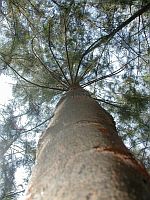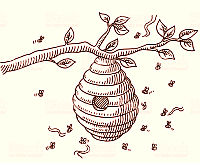


|
|
Coalsack NebulaStar Lore |
|


| The Coalsack Nebula is a dark nebula that obscures a section of the Milky Way in the southeast quadrant of the Southern Cross. It is the most prominent dark nebula in the skies and the topic of several legends in Africa, Australia and South America. |


| Africa |


|
|
!Kung
The !Kung people at the western edge of the
Kalahari Desert call the Coalsack Nebula the Old Bag of the Night.
|
 Dark patches of the Milky Way over the Kalahari
Dark patches of the Milky Way over the KalahariSource: Nasa Wallpapers |


| Australia |


|
|
Kamilaroi and Euahlayi
In A Comparison of Dark Constellations of the Milky Way,
Steven R. Gullberg et al. provides a good description of the patterns seen by Aboriginal people:
|
 Emu Rock Art in Ku-ring-gai Chase National Park, Sydney
Emu Rock Art in Ku-ring-gai Chase National Park, SydneySource: sydneyoutback.rezdy.com |
 Emu in the sky and on the rocks
Emu in the sky and on the rocks© Barnaby Norris |


|
|
Boorong
The Boorong call the emu Tchingal, its head is prominemtly formed by the Coalsack Nebula.
|
Tchingal is the giant emu that eats people and therefore made families live in constant fear of their lives. The crow grew tired of the
constant harassment and told of his dread to the Berm-Berm Gle brothers (the pointer stars
Alpha and Beta Centauri). They promised to help him if crow would lead them to the fearsome giant.
 The ensuing battle raged over a wide region, which helped to define the current landscape and ultimately their quarry was cornered. To their surprise it was the Singing Bush lark, Weetgurrk (Zeta Boötis), that delivered the deathblow, the final spear thrust, which secured the future safety for all people.  The heroic brothers then split each feather of the giant emu down the middle, casting one half of the feathers on the right hand side and the other half on the left, making two heaps. One of these heaps became the cock, the other the hen of the present race of emus, which are much, much smaller in size.  It was arranged that all future emus should lay a number of eggs instead of one only as the giant had. The splitting of the feathers is still easily observable in the twin-shafted feathers of all emus today.  On first sighting Tchingal in the night sky the observer is overwhelmed by its immensity. Its head is what other astronomers call the Coal Sack, just to the bottom left of the Southern Cross, its neck extends down through the pointers and its body is the large dark patch just before reaching Scorpius. Its legs hang down into the tail of Scorpius.  Source: Creativ Cowboy: Stars over Tyrell |
 Head of the emu
Head of the emuin the Coalsack Nebula (with Crux to the right) Source: Wikipedia
|


|
|
Wotjobaluk
The Wotjobaluk (also from what is now Victoria) have a similar
story. In their version, the brothers are called the Bram-bram-bult brothers and β Crucis is their
mother, called Druk.
The Wotjobaluk too see the Coalsack Nebula as the Giant Emu Tchingal, but in a different story also interpret the Nebula as the top of a giant
pine tree that can be used to climb to the sky.
|
 Australian Pine; etsy.com
Australian Pine; etsy.com
|


|
|
Wardaman
Australian writer W. E. Harney reports that to the Wardaman people of the
Northern Territory, the Coalsack Nebula represents head and shoulders of a law-man watching the people to ensure they do not break traditional law.
|
 Crux and Coalsack Nebula
Crux and Coalsack Nebula© amazingsky.net |


| South America |


|
|
Inca
 The Inca saw a number of constellations within the  Tinamou are birds indigenous to the Andes and are of very ancient lineage.  Steven R. Gullberg et al. A Comparison of Dark Constellations of the Milky Way Gullberg, Steven Roland: The cosmology of Inca huacas.
|
 Tinamou;
British Museum
Tinamou;
British Museum
|

Another Inca myth mentions the god Ataguchu. Ataguchu and his
twin brother Piguero are part of the Inca creation myths in which they showed the first people how to escape the underworld.
 In a myth told on the website of the European Southern Observatory, Ataguchu kicked the Milky Way in a fit of anger, causing a fragment to fly off and form the Small Magellanic Cloud. The Coalsack is the black mark left behind where the broken fragment was.  Sources: European Southern Observatory, constellation-guide.com |


 |

The Kalapalo people in what is now the Brazilian state of Mato Grosso
saw the Coalsack Nebula as a beehivehad and the stars
of the Southern Cross as Aganagi, angry bees that had emerged from the hive.
|
 Bee Hive
Bee HiveSource: clipart.email |


|
|
Mocoví
Alejandro López
relates the cosmology of the Mocoví people of the Gran Chaco area to the the Coalsack Nebula and
a mythical being called the Mañic.
|

|
A Mocoví mythical tale has that a powerful man decided to face the Mañic.
He chased the Mañic throughout the world and the cornered Mañic climbed up the ombú trunk (the tree of the world) to the sky.
 Today, the shadow-soul (la 'al) of the Mañic can be seen in the Milky Way's dark clouds, with its head in what we know as the Coalsack. Alpha and Beta Centauri are dogs chasing the Mañic and bite at its neck."  Source: Steven R. Gullberg et al. A Comparison of Dark Constellations of the Milky Way |
 The Mañic; art by Jessica Gullberg,
The Mañic; art by Jessica Gullberg,constellation from López and Alterlieb Source: researchgate.net |


| Modern Fiction |


|
|
The Coalsack Nebula is mentioned in two episodes of
Star Trek: The Original Series:
 - The Immunity Syndrome - Let That Be Your Last Battlefield.  In the star chart of the Star Trek Role Playing Game The Way of D'era: The Romulan Star Empire, the Nebula is shown within the United Federation of Planets at the border to the Romulan Star Empire  Source: memory-alpha.fandom.com |
 memory-beta.fandom.com
memory-beta.fandom.com
|


|
Back to Star Lore |
Back to Mythology |
Back to Space Page |
Back to English |
 Back to Start Page |